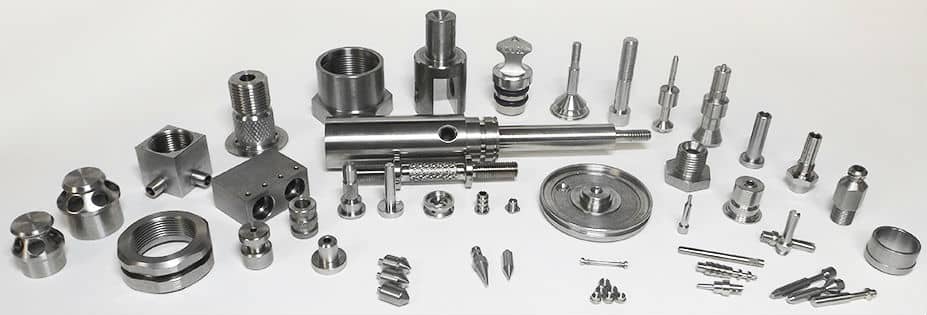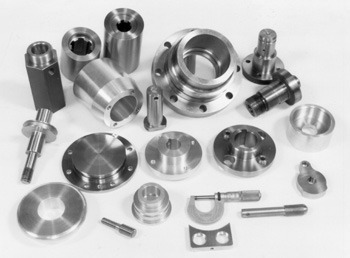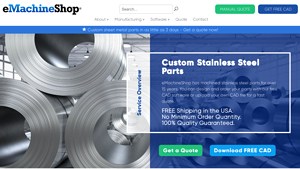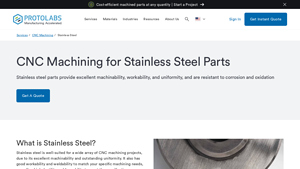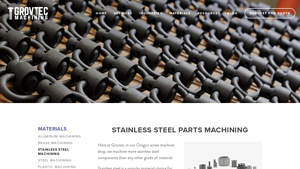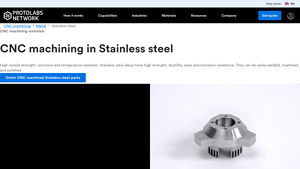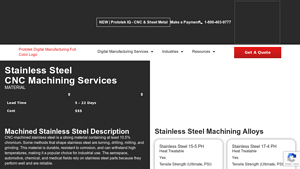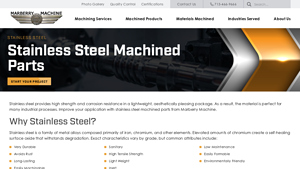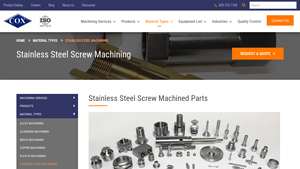Machined Stainless Steel Parts Guide: Type, Cost, Top List…
Introduction: Navigating the Global Market for machined stainless steel parts
The global market for machined stainless steel parts presents a myriad of opportunities, yet navigating this complex landscape can be daunting for international B2B buyers, particularly those in regions such as Africa, South America, the Middle East, and Europe, including Brazil and Saudi Arabia. One of the key challenges in sourcing these components lies in understanding the diverse types of stainless steel and their specific applications. This guide aims to demystify the intricacies of machined stainless steel parts by providing a comprehensive overview of various grades, including austenitic, ferritic, martensitic, and duplex steels, along with their unique properties and applications in sectors ranging from aerospace to food processing.
In addition to detailing the characteristics and uses of different stainless steel alloys, this guide will offer insights into supplier vetting processes, cost considerations, and the latest machining technologies. By equipping buyers with essential knowledge, the guide empowers them to make informed purchasing decisions that align with their operational needs and budgetary constraints. Whether you are seeking high-strength components for heavy machinery or corrosion-resistant parts for medical devices, understanding the nuances of machined stainless steel parts is crucial for ensuring quality and reliability in your supply chain.
Understanding machined stainless steel parts Types and Variations
| Type Name | Key Distinguishing Features | Primary B2B Applications | Brief Pros & Cons for Buyers |
|---|---|---|---|
| Austenitic Stainless Steel | Non-magnetic, excellent corrosion resistance, highly formable | Aerospace, automotive, medical instruments | Pros: High ductility, good weldability. Cons: Prone to stress corrosion cracking. |
| Ferritic Stainless Steel | Magnetic, lower ductility, good resistance to stress corrosion | Automotive fasteners, heat exchangers | Pros: Cost-effective, good resistance to oxidation. Cons: Limited formability. |
| Martensitic Stainless Steel | Heat treatable, higher strength but lower corrosion resistance | Pump shafts, valves, mining machinery | Pros: High strength, good wear resistance. Cons: Lower corrosion resistance, requires heat treatment. |
| Duplex Stainless Steel | Hybrid of austenitic and ferritic, high strength and corrosion resistance | Chemical processing, pressure vessels | Pros: Superior strength, good stress corrosion resistance. Cons: Difficult to cold form. |
| Precipitation Hardening | Heat treatable, high strength at elevated temperatures | Military equipment, aerospace components | Pros: Exceptional strength, retains properties at high temperatures. Cons: More complex machining process. |
What are the Characteristics of Austenitic Stainless Steel Parts?
Austenitic stainless steel is characterized by its non-magnetic nature and excellent corrosion resistance, making it highly suitable for demanding applications in aerospace, automotive, and medical industries. Common grades like 304 and 316 are favored for their formability and weldability, allowing for complex part designs. Buyers should consider the potential for stress corrosion cracking, particularly in environments with high chloride exposure, which may necessitate additional protective measures.
How Does Ferritic Stainless Steel Compare in Machining?
Ferritic stainless steel is known for its magnetic properties and lower ductility compared to austenitic grades. This type is often used in automotive fasteners and heat exchangers due to its cost-effectiveness and good resistance to oxidation. However, its limited formability means that complex shapes may be challenging to achieve. B2B buyers should weigh the advantages of lower costs against the potential need for alternative materials for intricate designs.
What Makes Martensitic Stainless Steel Suitable for Heavy-Duty Applications?
Martensitic stainless steel, with its heat-treatable nature, offers higher strength and wear resistance, making it ideal for heavy-duty applications like pump shafts and valves. While it provides significant strength, its lower corrosion resistance compared to austenitic and ferritic grades is a critical consideration for buyers. Companies in industries such as mining and manufacturing should evaluate the operational environment to determine the suitability of martensitic parts.
Why Choose Duplex Stainless Steel for Chemical Processing?
Duplex stainless steel combines the best features of austenitic and ferritic steels, providing high strength and excellent resistance to stress corrosion cracking. This makes it particularly valuable in chemical processing and pressure vessel applications. Although duplex grades are more challenging to cold form, their superior performance in harsh environments often justifies the investment. B2B buyers should assess the specific mechanical properties required for their applications before selection.
What are the Advantages of Precipitation Hardening Stainless Steel?
Precipitation hardening stainless steel is notable for its exceptional strength, especially at elevated temperatures, making it ideal for military and aerospace applications. These alloys are heat treatable, allowing for a tailored strength profile. However, the complexity of machining these materials may lead to increased production times and costs. Companies should consider the long-term benefits of durability against the upfront investment in machining capabilities.
Key Industrial Applications of machined stainless steel parts
| Industry/Sector | Specific Application of machined stainless steel parts | Value/Benefit for the Business | Key Sourcing Considerations for this Application |
|---|---|---|---|
| Medical Devices | Surgical instruments and implants | High corrosion resistance ensures patient safety. | Compliance with medical regulations and standards. |
| Food and Beverage | Processing equipment and storage tanks | Ensures hygiene and prevents contamination. | Certification for food safety and quality standards. |
| Aerospace | Aircraft components (e.g., fittings, valves) | Lightweight yet strong, enhancing fuel efficiency. | Material certifications and performance under extreme conditions. |
| Automotive | Engine components and exhaust systems | Durability and heat resistance improve vehicle longevity. | Precision manufacturing capabilities and quality assurance. |
| Oil and Gas | Pressure vessels and pipeline fittings | Corrosion resistance is critical for safety and reliability. | Adherence to industry standards and certifications. |
How Are Machined Stainless Steel Parts Utilized in Medical Devices?
In the medical sector, machined stainless steel parts are essential for manufacturing surgical instruments and implants. Their high corrosion resistance and biocompatibility ensure that the instruments maintain their integrity and safety during procedures. International buyers, particularly from regions like Africa and South America, must ensure that suppliers comply with stringent medical regulations and standards, such as ISO 13485. Additionally, understanding the specific material grades suitable for different medical applications is crucial for effective sourcing.
What Role Do Machined Stainless Steel Parts Play in the Food and Beverage Industry?
Machined stainless steel parts are pivotal in the food and beverage industry, where they are used in processing equipment and storage tanks. The material’s non-corrosive nature and ease of cleaning help maintain hygiene and prevent contamination, which is vital for food safety. Buyers in regions such as the Middle East and Europe should prioritize suppliers that possess certifications for food safety, such as FDA and NSF. Ensuring that parts meet local health regulations can significantly impact the efficiency and safety of food production processes.
How Are Machined Stainless Steel Parts Applied in Aerospace?
In the aerospace industry, machined stainless steel parts are utilized for critical components like fittings and valves in aircraft. Their lightweight yet robust properties contribute to enhanced fuel efficiency and overall performance. For international buyers, particularly in Europe and the Middle East, it is important to source parts that meet stringent aerospace material certifications, such as AS9100. Understanding the specific environmental conditions these components will face can also guide buyers in selecting the appropriate stainless steel grades.
What Are the Benefits of Using Machined Stainless Steel Parts in Automotive Applications?
In the automotive sector, machined stainless steel parts are commonly found in engine components and exhaust systems. Their durability and heat resistance contribute to the longevity and efficiency of vehicles. For B2B buyers in regions like Brazil and Saudi Arabia, it is crucial to work with suppliers who demonstrate precision manufacturing capabilities and offer robust quality assurance processes. Additionally, understanding the specific mechanical properties required for different automotive applications can aid in making informed sourcing decisions.
How Do Machined Stainless Steel Parts Enhance Safety in the Oil and Gas Industry?
Machined stainless steel parts are critical in the oil and gas industry for applications such as pressure vessels and pipeline fittings. Their excellent corrosion resistance is essential for ensuring safety and reliability in harsh environments. International buyers must consider suppliers who adhere to industry standards and provide the necessary certifications, such as API and ISO. Furthermore, understanding the specific requirements for pressure ratings and material specifications can greatly influence sourcing strategies for these critical components.
3 Common User Pain Points for ‘machined stainless steel parts’ & Their Solutions
Scenario 1: Difficulty in Ensuring Consistent Quality in Machined Parts
The Problem:
B2B buyers often face significant challenges in ensuring the consistent quality of machined stainless steel parts. Variability in production processes, supplier capabilities, and material quality can lead to inconsistencies that affect the performance and durability of parts. For instance, an automotive manufacturer sourcing components from different suppliers may find discrepancies in dimensions, surface finishes, or mechanical properties, resulting in compatibility issues during assembly and increased costs due to rework or replacements.
The Solution:
To mitigate quality inconsistencies, buyers should implement a robust supplier evaluation and selection process. This involves not only assessing potential suppliers’ technical capabilities and certifications but also their quality control measures. Requesting detailed documentation, such as material certifications and inspection reports, can provide insight into the supplier’s commitment to quality. Additionally, establishing a strong communication line with suppliers can help clarify specifications and address potential issues before they escalate. Regular audits and feedback loops can further ensure that quality standards are maintained consistently throughout the supply chain.
Scenario 2: Challenges in Selecting the Right Stainless Steel Alloy
The Problem:
Many B2B buyers struggle with choosing the appropriate stainless steel alloy for their specific applications. With various grades available—such as 304, 316, and 17-4PH—each with unique properties, the decision can be overwhelming. Misidentifying the right alloy can lead to failures in performance, especially in demanding environments like chemical processing or aerospace, where corrosion resistance and mechanical strength are critical. This can result in costly delays and compromised safety.
The Solution:
To navigate this challenge, buyers should invest time in understanding the specific requirements of their applications, including environmental conditions, load-bearing needs, and any regulatory compliance. Consulting with material engineers or experts can provide valuable insights into the properties of different stainless steel alloys. Furthermore, leveraging resources like material data sheets and case studies can help in comparing performance metrics. It is also beneficial to partner with suppliers who offer customized alloy solutions, ensuring that the selected material aligns perfectly with the application’s demands.
Scenario 3: High Costs Due to Inefficient Machining Processes
The Problem:
High machining costs can be a major pain point for companies that require precision machined stainless steel parts. Factors such as tooling wear, inefficient machining strategies, and prolonged production times can inflate costs, impacting overall project budgets. For instance, a manufacturer may find that their CNC machining processes are not optimized, leading to excessive scrap rates and lower throughput, which ultimately affects their bottom line.
The Solution:
To address these cost challenges, buyers should adopt a holistic approach to process optimization. This can include investing in advanced CNC machining technologies and tools designed specifically for stainless steel, which can improve efficiency and reduce wear. Additionally, conducting a thorough analysis of the machining process can identify bottlenecks and areas for improvement. Implementing lean manufacturing principles and regular training for machinists on best practices can enhance productivity and reduce waste. Collaborating closely with suppliers who offer engineering support can also lead to innovative machining solutions that further lower costs while maintaining quality.
Strategic Material Selection Guide for machined stainless steel parts
What Are the Key Properties of Common Stainless Steel Alloys for Machined Parts?
When selecting materials for machined stainless steel parts, understanding the properties of different stainless steel alloys is crucial. Here, we analyze four common types: Stainless Steel 304, 316, 17-4 PH, and Duplex Stainless Steel. Each alloy has unique characteristics that influence its performance in various applications.
How Does Stainless Steel 304 Perform in Machined Applications?
Stainless Steel 304 is one of the most widely used grades due to its excellent corrosion resistance and good formability. It can withstand temperatures up to 870°C (1600°F) in intermittent service and is often used in food processing, chemical containers, and architectural applications.
Pros: Its high ductility allows for easy machining and welding, making it suitable for complex designs. Additionally, it has a relatively low cost compared to other stainless steel grades.
Cons: While it offers good corrosion resistance, it is not suitable for environments exposed to chlorides, as it can lead to pitting corrosion.
Impact on Application: 304 is ideal for applications involving food and beverage processing, where hygiene is paramount.
Considerations for International Buyers: Compliance with standards such as ASTM A240 is essential. Buyers from regions like Europe and the Middle East may also prefer certifications that meet EU regulations.
What Are the Advantages of Using Stainless Steel 316?
Stainless Steel 316 is known for its superior corrosion resistance, especially in marine and chemical environments. It can handle temperatures up to 870°C (1600°F) in intermittent service, making it suitable for a wide range of applications, including medical devices and marine equipment.
Pros: The addition of molybdenum enhances its resistance to pitting and crevice corrosion, making it a preferred choice for harsh environments.
Cons: The cost is typically higher than 304, which may affect budget-sensitive projects.
Impact on Application: Its compatibility with aggressive media, such as seawater and acidic solutions, makes it ideal for marine and chemical processing applications.
Considerations for International Buyers: Buyers should ensure compliance with ASTM A240 and consider local standards like DIN or JIS, particularly in regions with stringent environmental regulations.
Why Choose 17-4 PH for High-Strength Applications?
17-4 PH stainless steel is a precipitation-hardening alloy known for its high strength and excellent corrosion resistance. It is suitable for applications requiring high mechanical properties, such as aerospace and military components.
Pros: It offers an excellent combination of strength and toughness, along with good machinability.
Cons: The heat treatment process can complicate manufacturing, leading to longer lead times.
Impact on Application: Its high strength makes it suitable for load-bearing components in demanding environments.
Considerations for International Buyers: Compliance with aerospace standards like AMS 5604 is critical, especially for buyers in the aerospace sector in Europe and North America.
What Makes Duplex Stainless Steel a Unique Choice?
Duplex stainless steel combines the properties of austenitic and ferritic stainless steels, offering high strength and excellent resistance to stress corrosion cracking. It is often used in chemical processing and oil and gas applications.
Pros: Duplex stainless steel has a lower density, which can lead to weight savings in applications where weight is a concern.
Cons: The complexity of machining duplex grades can lead to increased manufacturing costs and longer production times.
Impact on Application: Its high strength and corrosion resistance make it suitable for high-pressure applications in harsh environments.
Considerations for International Buyers: Buyers should be aware of compliance with standards like ASTM A240 and the importance of proper welding techniques to avoid issues in service.
Summary Table of Material Selection for Machined Stainless Steel Parts
| Material | Typical Use Case for machined stainless steel parts | Key Advantage | Key Disadvantage/Limitation | Relative Cost (Low/Med/High) |
|---|---|---|---|---|
| Stainless Steel 304 | Food processing, chemical containers | Good corrosion resistance and weldability | Not suitable for chloride environments | Low |
| Stainless Steel 316 | Marine and chemical processing | Superior pitting and crevice corrosion resistance | Higher cost compared to 304 | Med |
| 17-4 PH | Aerospace and military components | High strength and toughness | Complicated heat treatment process | High |
| Duplex Stainless Steel | Chemical processing, oil and gas applications | High strength with lower density | Difficult machining can increase costs | Med |
This guide provides a strategic overview for B2B buyers to make informed decisions when selecting materials for machined stainless steel parts, ensuring compliance and suitability for their specific applications.
In-depth Look: Manufacturing Processes and Quality Assurance for machined stainless steel parts
What are the Key Stages in the Manufacturing Process of Machined Stainless Steel Parts?
The manufacturing process for machined stainless steel parts involves several critical stages that ensure precision, quality, and durability. Understanding these stages is essential for B2B buyers looking to source high-quality components.
Material Preparation: How is Stainless Steel Processed Before Machining?
The first stage in manufacturing involves the selection and preparation of stainless steel material. Buyers must choose the appropriate stainless steel alloy based on their application requirements. Commonly used grades include 304, 316, and 17-4PH, each offering specific benefits such as corrosion resistance and strength.
Once the material is selected, it undergoes various preparation processes. This includes cutting the stainless steel sheets or bars to the required dimensions and ensuring that the surface is clean and free from contaminants. This step is crucial, as any impurities can affect the machining process and the final product’s quality.
Forming: What Techniques are Utilized in Machining Stainless Steel?
The forming stage primarily involves CNC (Computer Numerical Control) machining, which allows for high precision and repeatability. CNC machining techniques, such as milling, turning, and drilling, are commonly used to shape the stainless steel into the desired form.
Machining stainless steel can be challenging due to its hardness and toughness, which requires specialized tools and techniques. For instance, high-speed steel or carbide tools are often employed to enhance cutting efficiency and tool longevity. B2B buyers should inquire about the machining capabilities of suppliers to ensure they can handle the specific requirements of their projects.
Assembly: How are Machined Parts Assembled?
In many applications, machined stainless steel parts are not standalone components; they often require assembly with other parts. This stage may involve welding, fastening, or integrating with electronic or mechanical systems.
Quality control during assembly is essential to ensure that all components fit together correctly and function as intended. Buyers should ensure that suppliers have robust assembly processes and qualified personnel to handle these tasks.
Finishing: What Types of Finishing Techniques Enhance Product Quality?
Finishing processes are critical in enhancing the aesthetic and functional properties of machined stainless steel parts. Common finishing techniques include polishing, passivation, and coating. Polishing improves the surface finish, while passivation enhances corrosion resistance by removing free iron from the surface.
Additionally, surface treatments can be applied to meet specific industry standards or customer requirements. B2B buyers should discuss finishing options with suppliers to ensure the parts meet their quality expectations.
What Quality Assurance Standards are Relevant for Machined Stainless Steel Parts?
Quality assurance is a vital aspect of manufacturing machined stainless steel parts. International and industry-specific standards guide manufacturers in maintaining high-quality production processes.
Which International Standards Should Buyers be Aware Of?
ISO 9001 is one of the most recognized international quality management standards. It sets out the criteria for a quality management system, emphasizing customer satisfaction, process improvement, and regulatory compliance. Suppliers should demonstrate ISO 9001 certification to assure buyers of their commitment to quality.
For specific industries, additional certifications may be relevant. For example, the CE mark indicates compliance with European health, safety, and environmental protection standards, while API (American Petroleum Institute) certifications are crucial for suppliers in the oil and gas sector.
What are the Key Quality Control Checkpoints During Manufacturing?
Quality control (QC) involves several checkpoints throughout the manufacturing process:
- Incoming Quality Control (IQC): This stage involves inspecting raw materials upon arrival to ensure they meet specified standards.
- In-Process Quality Control (IPQC): Continuous monitoring during the manufacturing process helps identify any deviations from quality standards, allowing for immediate corrective actions.
- Final Quality Control (FQC): This final inspection ensures that the finished product meets all specifications and quality standards before delivery.
B2B buyers should inquire about the QC processes employed by suppliers to ensure they maintain stringent quality standards.
How Can B2B Buyers Verify Supplier Quality Control?
Verifying a supplier’s quality control practices is essential for B2B buyers, particularly in international markets. Here are several methods buyers can use to assess supplier quality:
What Steps Can Buyers Take to Conduct Supplier Audits?
Conducting supplier audits is an effective way to assess a supplier’s adherence to quality standards. Buyers can perform on-site audits to evaluate the manufacturing processes, quality management systems, and overall operational efficiency. During these audits, it’s crucial to review documentation related to quality control processes and any certifications the supplier holds.
How Can Buyers Utilize Quality Reports and Third-Party Inspections?
Suppliers should provide regular quality reports detailing their QC processes and outcomes. These reports can include metrics on defect rates, inspection results, and corrective actions taken.
Additionally, buyers can engage third-party inspection services to conduct independent evaluations of suppliers. These services can provide unbiased assessments of quality compliance and help identify any areas of concern.
What Nuances Should International Buyers Consider Regarding Quality Control?
For international B2B buyers, particularly from regions like Africa, South America, the Middle East, and Europe, understanding the nuances of quality control is essential. Different regions may have varying standards and expectations regarding quality assurance.
How Do Regional Standards Impact Supplier Selection?
Buyers should be aware of specific regional standards and regulations that may apply to their industries. For instance, the European Union has stringent regulations regarding product safety and environmental impact, which may not be as strict in other regions.
Understanding these differences can help buyers make informed decisions when selecting suppliers and ensure that the products they source comply with relevant regulations in their markets.
Why is Communication Key in Managing Quality Expectations?
Clear communication between buyers and suppliers is crucial for managing quality expectations. Buyers should articulate their quality requirements and any relevant standards to ensure alignment. Regular updates and feedback can foster a collaborative approach to quality assurance, ultimately leading to better outcomes for both parties.
In summary, a thorough understanding of the manufacturing processes and quality assurance practices for machined stainless steel parts is essential for B2B buyers. By focusing on the key stages of manufacturing, familiarizing themselves with relevant quality standards, and actively verifying supplier practices, buyers can ensure they source high-quality components that meet their specific needs.
Practical Sourcing Guide: A Step-by-Step Checklist for ‘machined stainless steel parts’
When sourcing machined stainless steel parts, a methodical approach can significantly enhance your procurement process. This guide outlines essential steps for B2B buyers, ensuring that you make informed decisions that align with your project’s requirements.
Step 1: Define Your Technical Specifications
Before reaching out to suppliers, clearly outline your technical specifications. This includes dimensions, tolerances, surface finishes, and material grade (e.g., 304, 316). Precise specifications help suppliers provide accurate quotes and reduce the likelihood of errors during production.
Step 2: Research Potential Suppliers
Conduct thorough research to identify potential suppliers who specialize in machined stainless steel parts. Look for companies with a proven track record in your industry. Utilize online directories, industry forums, and trade shows to gather a list of candidates, ensuring you consider their geographical location, especially if logistics are a concern.
Step 3: Evaluate Supplier Capabilities
Assess the capabilities of your shortlisted suppliers. Inquire about their machinery, technology, and production processes. Ensure they can meet your volume requirements and deadlines while maintaining quality. Key points to investigate include:
– Types of CNC machines and tools used
– Quality assurance processes in place
– Experience with similar projects
Step 4: Request and Review Quotes
Once you have a list of qualified suppliers, request detailed quotes. Ensure each quote includes pricing, lead times, and payment terms. Compare these elements across suppliers to identify the best option. Pay attention to any additional costs, such as shipping and handling, which can impact your overall budget.
Step 5: Verify Supplier Certifications
Confirm that the suppliers adhere to industry standards and possess relevant certifications, such as ISO 9001 for quality management. This verification assures you of their commitment to quality and helps mitigate risks associated with substandard materials or processes.
Step 6: Ask for Samples or Prototypes
Before finalizing your order, request samples or prototypes of the parts you need. This step allows you to assess the quality and precision of their machining. Evaluate the samples against your specifications and consider conducting tests relevant to your application.
Step 7: Establish Clear Communication Channels
Effective communication is vital throughout the sourcing process. Ensure you establish clear channels for discussing project updates, potential issues, and feedback. Regular check-ins can help maintain transparency and foster a collaborative relationship, ultimately leading to a successful procurement experience.
By following this checklist, you can streamline your sourcing process for machined stainless steel parts, ensuring you choose the right supplier who can meet your specifications and deliver quality products on time.
Comprehensive Cost and Pricing Analysis for machined stainless steel parts Sourcing
What Are the Key Cost Components in Sourcing Machined Stainless Steel Parts?
When sourcing machined stainless steel parts, understanding the cost structure is essential for optimizing procurement strategies. The primary cost components include:
-
Materials: The cost of stainless steel varies significantly based on the alloy type. Common grades like 304 and 316 are widely used, with 304 generally being less expensive. Prices fluctuate based on market conditions, availability, and global demand.
-
Labor: Labor costs depend on the complexity of machining processes. Skilled labor is required for precise machining, especially when dealing with intricate designs or specialized stainless steel alloys. Higher labor costs are often associated with regions that have stricter labor laws or higher living costs.
-
Manufacturing Overhead: This encompasses costs related to facility maintenance, utilities, and equipment depreciation. Overhead can vary based on the manufacturer’s location and operational efficiency.
-
Tooling: Custom tooling for specific parts can be a significant upfront investment. Tooling costs are influenced by the complexity of the part design and the materials used, with more complex designs requiring more sophisticated tools.
-
Quality Control (QC): Ensuring high-quality standards is crucial, especially in industries like aerospace and medical. QC processes add to the overall cost but are necessary to mitigate risks associated with defective parts.
-
Logistics: Shipping costs can vary greatly depending on the supplier’s location, shipping method, and any associated tariffs or duties. International shipping can introduce additional complexities, such as customs clearance fees.
-
Margin: Suppliers will add a profit margin to cover their costs and ensure profitability. This margin can vary based on the supplier’s positioning in the market and the competitive landscape.
How Do Price Influencers Impact the Cost of Machined Stainless Steel Parts?
Several factors influence the pricing of machined stainless steel parts, making it crucial for buyers to consider these elements in their sourcing strategy:
-
Volume and Minimum Order Quantity (MOQ): Suppliers often offer discounts for larger orders. Understanding the MOQ can help buyers determine if they can take advantage of economies of scale.
-
Specifications and Customization: Custom parts with unique specifications generally incur higher costs. Buyers should assess whether customization is necessary or if standard components can suffice.
-
Material Quality and Certifications: The grade of stainless steel and relevant certifications (such as ISO standards) can significantly affect pricing. Higher-quality materials typically command higher prices but may offer better performance and longevity.
-
Supplier Factors: The reputation and reliability of suppliers can influence pricing. Established suppliers with a track record of quality and timely delivery may charge more but could save costs in the long run by minimizing defects and delays.
-
Incoterms: Understanding the terms of shipping and delivery is vital. Incoterms dictate responsibilities and costs related to shipping, insurance, and customs clearance, impacting the overall price.
What Negotiation Tips Can Help Buyers Optimize Costs?
For international B2B buyers, particularly those from Africa, South America, the Middle East, and Europe, effective negotiation can lead to significant cost savings:
-
Leverage Volume Discounts: If feasible, consolidate orders to meet or exceed MOQ thresholds, as this can lead to better pricing.
-
Understand Total Cost of Ownership (TCO): Evaluate not just the upfront costs but also the long-term costs associated with quality, maintenance, and potential failures. Sometimes, a higher initial investment in quality can yield lower TCO.
-
Build Relationships: Establishing strong relationships with suppliers can lead to better pricing and terms. Long-term partnerships often yield advantages in flexibility and service.
-
Research Market Prices: Being informed about current market trends and prices allows buyers to negotiate from an informed position, potentially leading to better deals.
-
Consider Local Suppliers: Sourcing from local suppliers can reduce logistics costs and complexities associated with international shipping, which is particularly beneficial for buyers in developing regions.
What Should Buyers Keep in Mind Regarding Pricing Nuances for International Sourcing?
International buyers should remain aware of specific nuances that can affect pricing:
-
Currency Fluctuations: Exchange rate variations can impact the final cost of parts. Buyers should consider locking in rates or negotiating in their local currency.
-
Import Duties and Tariffs: Understanding the import regulations and associated costs in the buyer’s country can help avoid unexpected expenses.
-
Cultural Considerations: Different regions have varying business practices and negotiation styles. Being culturally aware can facilitate smoother negotiations and stronger supplier relationships.
Disclaimer
Prices for machined stainless steel parts can vary widely based on numerous factors, including market conditions and specific buyer requirements. It is recommended to obtain multiple quotes and conduct thorough market research to ensure competitive pricing.
Alternatives Analysis: Comparing machined stainless steel parts With Other Solutions
Understanding Alternative Solutions to Machined Stainless Steel Parts
In the realm of manufacturing and component production, selecting the right material or method is crucial for achieving optimal performance, cost-effectiveness, and longevity. While machined stainless steel parts are renowned for their strength, corrosion resistance, and versatility, it’s essential for B2B buyers to consider alternative solutions that may meet specific requirements or constraints. This analysis will compare machined stainless steel parts with two viable alternatives: aluminum machining and plastic injection molding.
Comparison Table
| Comparison Aspect | Machined Stainless Steel Parts | Aluminum Machining | Plastic Injection Molding |
|---|---|---|---|
| Performance | High strength, corrosion-resistant, durable | Lightweight, good strength-to-weight ratio | Lightweight, can be molded into complex shapes |
| Cost | Higher initial cost; good long-term ROI | Moderate cost; can be more economical in bulk | Lower upfront costs; high tooling costs for small runs |
| Ease of Implementation | Requires specialized machining expertise | Generally easier to machine than stainless steel | Fast production once tooling is established |
| Maintenance | Low; highly durable | Moderate; prone to corrosion without treatment | Low; dependent on the environmental conditions |
| Best Use Case | Heavy-duty applications, aerospace, automotive | Aerospace, automotive, and structural applications | High-volume production of consumer goods, toys, and components |
Detailed Breakdown of Alternatives
Aluminum Machining
Aluminum is a popular alternative to stainless steel due to its lightweight properties and good strength-to-weight ratio. This makes it particularly advantageous in industries like aerospace and automotive, where reducing weight is critical. Aluminum can be machined with relative ease, leading to lower labor costs. However, it does not offer the same level of corrosion resistance as stainless steel and can require protective coatings in certain environments. Buyers should weigh the benefits of reduced weight and cost against potential durability issues in corrosive settings.
Plastic Injection Molding
Plastic injection molding is an efficient manufacturing method for producing large volumes of components quickly and at a lower cost. This method allows for intricate designs that can be molded into complex shapes, making it suitable for consumer goods and various industrial applications. The initial tooling costs can be high, which may not be economical for smaller production runs. However, once set up, the production process is fast and cost-effective. Buyers should consider the application; while plastics can offer flexibility and lower weight, they may not provide the same strength or temperature resistance as machined stainless steel.
Conclusion: How to Choose the Right Solution for Your Needs
When selecting between machined stainless steel parts and alternative solutions, B2B buyers should evaluate their specific project requirements, including performance expectations, budget constraints, and production volume. Machined stainless steel is ideal for applications demanding high durability and corrosion resistance, while aluminum machining is better suited for weight-sensitive projects. Plastic injection molding offers cost-effective solutions for high-volume production but may lack the robustness required for demanding applications. By carefully considering these factors, buyers can make informed decisions that align with their operational goals and deliver optimal results.
Essential Technical Properties and Trade Terminology for machined stainless steel parts
What Are the Key Technical Properties of Machined Stainless Steel Parts?
When sourcing machined stainless steel parts, understanding the critical technical properties is essential for making informed decisions. Here are the most significant specifications:
-
Material Grade
Stainless steel is categorized into various grades based on its composition and properties. Common grades include 304, 316, and 17-4 PH. Each grade offers unique benefits, such as corrosion resistance or heat tolerance. Selecting the right grade is crucial for ensuring that the parts meet the specific requirements of their intended application, such as in medical, aerospace, or automotive industries. -
Tolerances
Tolerance refers to the permissible limit or limits of variation in a physical dimension. In machining, tight tolerances (e.g., ±0.001 inches) are often necessary for parts that must fit precisely in assemblies. Understanding tolerances is vital for B2B buyers as it impacts the part’s functionality and compatibility with other components, thereby influencing overall product quality. -
Surface Finish
The surface finish of machined parts affects both their aesthetics and performance. Common finishes include polished, brushed, or matte. A good surface finish can enhance corrosion resistance and reduce friction, which is particularly important in applications like valves or pumps. Buyers should specify the desired finish to ensure that the parts meet both functional and aesthetic standards. -
Machinability
Machinability refers to how easily a material can be machined to a desired shape and surface finish. Stainless steels vary in machinability, with grades like 303 being easier to machine than 304. Understanding machinability is essential for buyers to anticipate production timelines and costs, as more difficult materials may require advanced tooling or longer machining times. -
Yield Strength and Tensile Strength
Yield strength is the stress at which a material begins to deform plastically, while tensile strength is the maximum stress a material can withstand while being stretched or pulled before breaking. These properties are critical for applications that experience high loads or stresses, such as structural components in construction or automotive parts. Buyers should evaluate these strengths to ensure that parts will perform reliably under expected conditions. -
Corrosion Resistance
One of the primary advantages of stainless steel is its corrosion resistance, which varies by grade and alloying elements. Grades like 316 offer superior resistance to corrosive environments, making them ideal for marine applications or chemical processing. Buyers should assess the environmental conditions the parts will be exposed to in order to select a material that will ensure longevity and reduce maintenance costs.
What Are Common Trade Terms in the Machined Stainless Steel Industry?
Familiarizing yourself with industry jargon can facilitate smoother transactions and better communication with suppliers. Here are some key terms:
-
OEM (Original Equipment Manufacturer)
An OEM is a company that produces parts or equipment that may be marketed by another manufacturer. Understanding OEM specifications ensures that you receive components that meet your quality and performance standards. -
MOQ (Minimum Order Quantity)
MOQ refers to the smallest quantity of a product that a supplier is willing to sell. Knowing the MOQ is essential for budgeting and inventory management, especially for businesses that may require custom parts in limited quantities. -
RFQ (Request for Quotation)
An RFQ is a document issued by a buyer to request price and other terms for specific products or services. Submitting an RFQ helps buyers compare quotes from different suppliers and negotiate better terms. -
Incoterms (International Commercial Terms)
Incoterms are standardized international shipping terms that define the responsibilities of buyers and sellers regarding shipping, insurance, and tariffs. Understanding these terms is crucial for international transactions, as they can significantly impact total costs and delivery timelines. -
CNC (Computer Numerical Control)
CNC refers to automated machining processes controlled by computers. This technology enhances precision and efficiency in manufacturing machined parts, making it a vital consideration when discussing production capabilities with suppliers. -
Lead Time
Lead time is the amount of time from placing an order to the delivery of the finished product. Understanding lead times helps buyers plan their supply chain and manage inventory more effectively, ensuring that production schedules are met without delays.
By grasping these technical properties and trade terms, B2B buyers can enhance their sourcing strategy, ensuring they select the right machined stainless steel parts for their applications.
Navigating Market Dynamics and Sourcing Trends in the machined stainless steel parts Sector
Market Overview & Key Trends in Machined Stainless Steel Parts
The global market for machined stainless steel parts is experiencing robust growth, driven by several key factors. The increasing demand for high-strength, corrosion-resistant materials across diverse industries such as aerospace, automotive, and medical devices is a primary driver. Particularly in regions like Africa, South America, the Middle East, and Europe, there is a noticeable shift towards advanced manufacturing technologies, including CNC machining and additive manufacturing, which enhance production efficiency and precision.
Emerging trends indicate a rising emphasis on customization and rapid prototyping. B2B buyers are increasingly looking for suppliers that offer flexible manufacturing capabilities, allowing for low minimum order quantities and quick turnaround times. This trend is particularly significant for international buyers seeking to optimize their supply chains and reduce lead times. Additionally, the integration of digital tools such as CAD software for design and quoting is becoming standard, facilitating smoother communication between buyers and manufacturers.
The machined stainless steel parts sector is also witnessing a shift towards greater transparency and traceability in sourcing. As international buyers become more discerning, they are prioritizing suppliers that can demonstrate compliance with quality standards and provide detailed documentation of material properties and sourcing practices. This trend is essential for maintaining competitive advantage in a market that is increasingly focused on quality and reliability.
How Does Sustainability Impact the Sourcing of Machined Stainless Steel Parts?
Sustainability is becoming a crucial consideration in the sourcing of machined stainless steel parts. The environmental impact of manufacturing processes, particularly concerning energy consumption and waste generation, is under scrutiny. B2B buyers are increasingly favoring suppliers that employ sustainable practices, such as using recycled materials and minimizing carbon footprints during production. This shift not only addresses environmental concerns but also appeals to a growing segment of consumers who value sustainability in product sourcing.
Ethical sourcing is equally important in today’s market. Suppliers that adhere to ethical labor practices and demonstrate a commitment to fair trade are more likely to attract business from conscious buyers. Certifications such as ISO 14001 for environmental management and Fair Trade certification are becoming critical differentiators in supplier selection. By prioritizing suppliers with these credentials, international buyers can ensure that their supply chains align with their corporate social responsibility goals.
Furthermore, the use of ‘green’ materials in the production of machined stainless steel parts is gaining traction. Buyers are encouraged to explore options like eco-friendly coatings and finishes that enhance the performance of stainless steel while minimizing environmental impact. This focus on sustainability not only bolsters brand reputation but can also lead to long-term cost savings through improved efficiency and reduced waste.
What is the Historical Context Behind the Evolution of Machined Stainless Steel Parts?
The evolution of machined stainless steel parts can be traced back to the early 20th century, when stainless steel was first developed. The unique properties of stainless steel, including its corrosion resistance and strength, quickly established it as a preferred material in various applications. Over the decades, advancements in metallurgical science and machining technology have expanded the range of stainless steel alloys available, each tailored for specific industrial needs.
In the latter half of the 20th century, the rise of CNC machining revolutionized the manufacturing process, allowing for greater precision and efficiency in the production of machined parts. This technological advancement enabled manufacturers to produce complex geometries and custom parts at scale, further driving the adoption of stainless steel in critical sectors such as aerospace and medical devices.
Today, the market continues to evolve, driven by innovations in digital manufacturing and a growing emphasis on sustainable practices. This historical context highlights the adaptability of machined stainless steel parts to meet the changing demands of global industries, positioning them as a staple in modern manufacturing. As international B2B buyers navigate this landscape, understanding these historical trends can inform strategic sourcing decisions and foster stronger supplier relationships.
Frequently Asked Questions (FAQs) for B2B Buyers of machined stainless steel parts
-
How do I ensure the quality of machined stainless steel parts from international suppliers?
To ensure quality, start by vetting potential suppliers through certifications such as ISO 9001, which indicates a commitment to quality management. Request samples of their work to evaluate craftsmanship and adherence to specifications. Additionally, establish clear quality assurance protocols, including inspections at various stages of production, and consider third-party quality audits for added assurance. Building a strong communication channel with the supplier can help address any quality concerns promptly. -
What are the most common types of stainless steel used in machining?
The most common types of stainless steel for machining include 304, 316, and 17-4 PH. Stainless Steel 304 is widely recognized for its excellent corrosion resistance and formability, making it suitable for various applications. Stainless Steel 316 offers enhanced corrosion resistance, particularly in marine environments, while 17-4 PH is known for its high strength and heat treatability, ideal for demanding applications. Choosing the right type depends on the specific requirements of your project. -
What should I consider when customizing machined stainless steel parts?
When customizing parts, consider factors such as material specifications, tolerances, surface finishes, and any applicable industry standards. Clearly define your design requirements and communicate them with your supplier to ensure feasibility. Additionally, factor in lead times for design modifications and potential costs associated with custom tooling or processes. Collaborating closely with the supplier during the design phase can help optimize manufacturability and reduce production delays. -
What are the minimum order quantities (MOQs) for machined stainless steel parts?
Minimum order quantities can vary significantly among suppliers and depend on factors such as the complexity of the parts, production methods, and material costs. Some suppliers may have no MOQ, allowing for prototype orders, while others may require a certain number to justify setup costs. It’s essential to clarify MOQs before placing an order, especially if you’re looking to source parts in small quantities or for initial testing purposes. -
What payment terms are typically offered by suppliers of machined stainless steel parts?
Payment terms can vary, but common arrangements include upfront deposits (often 30% to 50%), followed by the balance upon delivery or after a specified period post-delivery. Some suppliers may offer net payment terms, such as net 30 or net 60 days, allowing time for review and acceptance of the products before payment is due. Ensure to negotiate terms that align with your cash flow needs and risk tolerance while maintaining a good relationship with the supplier. -
How can I manage logistics when sourcing stainless steel parts internationally?
Managing logistics involves coordinating shipping, customs clearance, and final delivery. Work with suppliers who have experience in international shipping and can assist with documentation and compliance. Consider using a freight forwarder for more efficient handling of logistics, as they can provide guidance on the best shipping methods and routes. Be aware of import duties and taxes in your country, and plan for potential delays in transit to avoid disruption in your supply chain. -
What are the common applications for machined stainless steel parts in various industries?
Machined stainless steel parts are utilized across numerous industries, including aerospace, automotive, medical, and food processing. Common applications include components for machinery, medical instruments, automotive parts, and structural elements in construction. Their corrosion resistance and strength make them ideal for environments that demand durability and reliability. Understanding your industry’s specific requirements can help in selecting the appropriate materials and designs for your applications. -
How do I resolve issues with my order of machined stainless steel parts?
If you encounter issues with your order, promptly communicate with your supplier. Clearly outline the problems, whether they relate to quality, specifications, or delivery timelines. Most reputable suppliers will have processes in place for addressing concerns, including returns or adjustments. Documenting all communications and maintaining a record of agreements can facilitate a smoother resolution process. Establishing a collaborative relationship with your supplier can also help prevent future issues.
Important Disclaimer & Terms of Use
⚠️ Important Disclaimer
The information provided in this guide, including content regarding manufacturers, technical specifications, and market analysis, is for informational and educational purposes only. It does not constitute professional procurement advice, financial advice, or legal advice.
While we have made every effort to ensure the accuracy and timeliness of the information, we are not responsible for any errors, omissions, or outdated information. Market conditions, company details, and technical standards are subject to change.
B2B buyers must conduct their own independent and thorough due diligence before making any purchasing decisions. This includes contacting suppliers directly, verifying certifications, requesting samples, and seeking professional consultation. The risk of relying on any information in this guide is borne solely by the reader.
Top 7 Machined Stainless Steel Parts Manufacturers & Suppliers List
1. eMachineShop – Custom Stainless Steel Parts
Domain: emachineshop.com
Registered: 1999 (26 years)
Introduction: Custom Stainless Steel Parts offered by eMachineShop include:
– Over 15 years of experience in machining stainless steel parts.
– Free CAD software for designing and ordering parts or the option to upload your own CAD file for a fast quote.
– Free shipping in the USA.
– No minimum order quantity.
– 100% quality guaranteed.
Key properties of stainless steel:
– High strength
– Self-protective
– Exc…
2. Protolabs – CNC Machining Services for Stainless Steel
Domain: protolabs.com
Registered: 2006 (19 years)
Introduction: Protolabs offers CNC machining services for stainless steel, providing precision parts with tight tolerances. The service includes a variety of stainless steel grades, such as 303, 304, 316, and 17-4 PH, suitable for various applications. The machining process allows for complex geometries and high-quality finishes, with quick turnaround times and low minimum order quantities. Protolabs also empha…
3. GrovTec Machining – Precision Stainless Steel Machining
Domain: grovtecmachining.com
Registered: 2014 (11 years)
Introduction: GrovTec Machining specializes in stainless steel machining, offering precision machining services for various industries including aerospace, military & defense, electronics, medical, oil and gas, and firearms. The company machines more stainless steel components than any other material, utilizing CNC mills, screw machines, and CNC swiss machines. Common stainless steel grades processed include 30…
4. Hubs – Stainless Steel CNC Services
Domain: hubs.com
Registered: 1998 (27 years)
Introduction: Stainless steel CNC services offer custom stainless steel parts with high tensile strength, corrosion resistance, and temperature resistance. The materials available include various stainless steel alloys such as 304/304L, 316/316L, 303, 17-4 PH, 416, 2205 Duplex, 420, 440C, 430, 301, and 15-5. Key characteristics include excellent mechanical properties, high accuracy and repeatability, and a lead…
5. Prototek – CNC-Machined Stainless Steel
Domain: prototek.com
Registered: 1996 (29 years)
Introduction: Machined Stainless Steel Description: CNC-machined stainless steel is a strong material containing at least 10.5% chromium. It is durable, resistant to corrosion, and can withstand high temperatures, making it popular for industrial use. Key Characteristics: Biocompatible, Chemical Resistant, Corrosion Resistant, High Ductility, High Strength, Temperature Resistant, Wear Resistant. Applications: A…
6. Marberry Machine – Stainless Steel Machined Parts
Domain: marberrymachine.com
Registered: 1999 (26 years)
Introduction: Stainless Steel Machined Parts from Marberry Machine, Inc. provide high strength and corrosion resistance in a lightweight, aesthetically pleasing package. Key attributes include durability, rust avoidance, long-lasting performance, machinability, sanitation, high tensile strength, low maintenance, and recyclability. Marberry Machine is an ISO 9001:2015-, ITAR-, and JCP-certified manufacturer, off…
7. Cox Manufacturing – Precision Stainless Steel Machining
Domain: coxmanufacturing.com
Registered: 2003 (22 years)
Introduction: Cox Manufacturing specializes in stainless steel screw machining and machined parts, offering high-quality CNC machining services. They produce precision components using various stainless steel alloys, including Alloy 303, Alloy 304, Alloy 316, Alloy 430 FR, Alloy 440, and Alloy 17-4 PH. The company utilizes advanced automated machining equipment, including CNC Swiss, multi-spindle, and CNC milli…
Strategic Sourcing Conclusion and Outlook for machined stainless steel parts
How Can Strategic Sourcing Enhance Your Supply Chain for Machined Stainless Steel Parts?
In conclusion, strategic sourcing is vital for international B2B buyers seeking machined stainless steel parts. By understanding the diverse types of stainless steel and their specific applications, businesses can make informed decisions that align with their operational needs. The selection of the right supplier not only ensures high-quality components but also fosters long-term partnerships that can lead to cost savings and improved efficiency.
As the demand for durable, corrosion-resistant materials continues to rise across various industries—ranging from aerospace to food processing—investing in a robust sourcing strategy becomes essential. Buyers should prioritize suppliers who offer flexible order quantities, rapid turnaround times, and comprehensive support services, as these factors significantly impact overall project success.
Looking ahead, the global marketplace is evolving. Buyers from regions such as Africa, South America, the Middle East, and Europe are encouraged to leverage technological advancements and digital platforms to streamline their sourcing processes. Embrace innovation, seek competitive quotes, and build relationships with reliable manufacturers to position your business for future growth. Now is the time to act—secure your supply chain for machined stainless steel parts and stay ahead in this competitive landscape.
